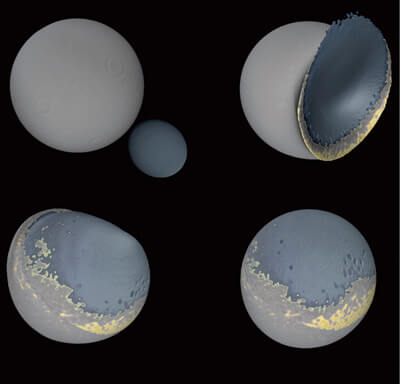In an article published yesterday, researchers from the University of California at Santa Cruz claim that the contents of the second moon were crushed and thickened the side of the moon that was positioned as the side farthest from us
Nancy Atkinson

This is a sight science fiction fans hope for - two moons in the night sky above Earth. But this sight was last seen 4 billion years ago. A new model suggests that the high levels on the far side of the moon were formed as a result of a collision with a smaller companion moon that researchers at the University of California, Santa Cruz, call the "big crush."
Why the near side and the far side of the moon are so different is a puzzle that has haunted planetary scientists for years. The near side is low and relatively flat while the topography of the far side is high and mountainous, and the crust there is thicker. In principle we actually have a moon that leans mostly to one side.
In a study published in the August 4 issue of the journal Nature, the big collision model for the creation of the moon is described in which an object the size of Mars collided with the Earth at the beginning of the history of the solar system and ejected remnants that combined to form the moon.
A new computer model shows that a second moon that was 1,200 kilometers in diameter formed around Earth in the same collision. Later, the smaller object fell into the large moon and coated one side of it with another layer of solid crust tens of kilometers thick.
"Our model works well and is consistent with the massive collision model that formed the Moon and which predicts that there will be other massive fragments that will surround the Earth in addition to the Moon itself" says Eric Aspod, Professor of Earth and Planetary Sciences at the University of California, Santa Cruz. "The model is compatible with the knowledge we have about the dynamic stability of such a system, the timing of the moon's cooling and the age of the lunar rocks."
Other computer models have suggested the existence of a companion star," says Espod, who conducted the study together with PhD student Martin Joci. The two used computer simulations to study the dynamics of the collision between the moon and smaller objects, having a mass of one-thirtieth of the main moon, and followed the evolution and distribution of the lunar material after the collision. The collision between the two bodies was relatively slow - at a speed of about 8,000 km/h, slow enough so that the rocks would not melt and an impact crater would not form. Instead, the rocks and crust from the smaller moon will be spread over a large area.
Of course, modelers will try to explain everything through collisions. In this case, a very strange collision is required: a slow one, which does not create a crater but crushes material on one side" explained Aspod. "It's something new that needs to be thought about."
Espod and Jocchi hypothesized that the companion moon was initially captured by one of the Lagrange points - the Trojan points - and shared an orbit with the moon. Then as the moon's orbit moved away from Earth, the orbit the secondary moon was in became unstable. "The collision could have been anywhere on the surface of the moon" explains Joci. "The final body leans to one side and it repositioned itself so that it stabilized on the side far from the Earth."
The model also explains the variation in the composition of the lunar crust, which on the side closest to the Earth is rich in potassium and phosphorus. These elements, as well as uranium and thorium, were found, according to the hypothesis, in high concentration in the magma ocean that survived as icy rocks that solidified under the thickening crust on the moon. In the simulations, the collision smashed the layer rich in these materials into the opposite hemisphere, setting the stage for the geology we see today on the near side of the Moon.
While the model explains many things, it is still not accepted by all planetary scientists as an explanation for the full history of the Moon. Scientists say the best way to discover the history of the moon is to collect more data from spacecraft orbiting the moon and even launch manned or other missions to collect soil from the moon and study these rocks.
